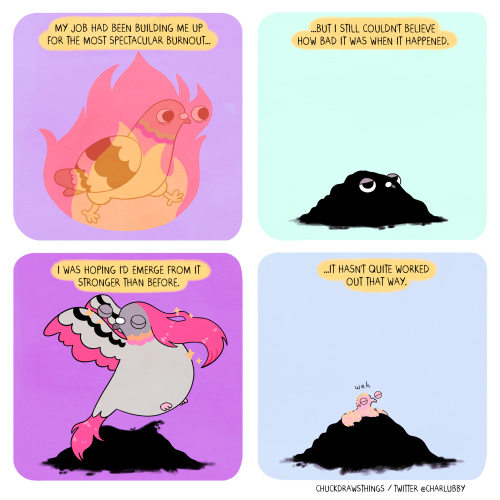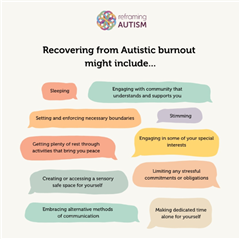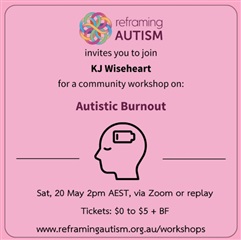(This piece of writing was created by my incredible friend Shelly and myself for our Neurodiversity and Wellness, Arts and Culture community that we chair)
You might hear the term “Burnout” talked about a lot and maybe you’ve felt that way yourself.
But what is burnout?
How does burnout differ between different communities?
And what can you do about it for your co-workers, friends and yourself?

Defining Burnout
The World Health Organisation (WHO) points out that whilst burn-out is included in the 11th Revision of the International Classification of Diseases (ICD-11) as an occupational phenomenon, it is not classified as a medical condition.[1]
Burn-out is defined in ICD-11 as:
“a syndrome conceptualised as resulting from chronic workplace stress that has not been successfully managed. It is characterised by three dimensions:
• feelings of energy depletion or exhaustion;
WORLD HEALTH ORGANIZATION (MAY, 2019)
• increased mental distance from one’s job, or feelings of negativism or cynicism related to one’s job; and
• reduced professional efficacy.”
However, as the boundaries between work and home have blurred throughout the covid years, the occupational distinction has also become less fitting. Evidence shows that burnout makes no distinction between paid or unpaid work and people undertaking unpaid home or care duties can also be impacted[2].
The Black Dog Institute and the UNSW School of Psychiatry[2a] have carried out studies into factors that commonly concur with burnout, including:
- Anxiety/stress
- Depression and low mood
- Irritability and anger
- Sleep disturbances
- Lack of motivation or passion
- Lack of concentration, memory loss or brain fog
- Withdrawal from others
- Physical symptoms such as aches, headaches, nausea and low libido
- Emotional fragility
It raises the chicken v egg question on whether these factors are a cause of or caused by burnout, or whether they are all a symptom of an underlying issue. The same researchers are also undertaking a followup study to further investigate the features of burnout and its relationship with depression.
Neurodivergent Burnout
In the neurodivergent communities, conversations about burnout are quite common. In fact many neurodivergent people come to uncover their uniqueness due to the burnout of trying to fly under the radar. The challenges of living and working in a society not designed for us can mean frequent overload that can push us into meltdown, shutdown, and burnout. Also life-changes can exacerbate challenges, for example transitioning from school to work, experiencing a mental health crisis, or the death of someone close[13]. Stigma can make prevention and recovery even harder.
So how does neurodivergent burnout differ from the WHO defined burnout?
A notable difference is in the causes of burnout [6]. Some of factors that lead to burnout for ND folk are:
- Repeated sensory overload
- Long term masking
- Having social/sensory needs minimised by others due to appearing “fine” (i.e. “successful” masking)
- Not having access to the appropriate level of supports & accommodations
- Difficult or unreachable expectations from family, school, work, or society
- Executive Functioning fatigue following a number of stressors or transitions
- When the overall load exceeds abilities + supports = burnout
But impacts of burnout can also present differently, including [7]:
- Loss of skills
- Loss of interest in dedicated interest areas
- Emotional regulation issues
- Added anxiety and depression
A study by Dr Dora Rainmaker at Portland State University[11], involved interviews with autistic adults. Whilst her studies have been in the autistic population, the sentiment aligns with other neurodivergent communities. Findings included:
“… struggling with independent living, loss of self-belief, and being frightened that the loss of skills from the autistic burnout might be permanent.”
Dr. Dora Rainmaker
The results also pointed to a “lack of empathy from neurotypical people, who had difficulty understanding or relating to the autistic person’s experiences.”
What can we do about it?
Policy
On a policy level, it may be good to know that groups such as the Black Dog Institute are campaigning for workplace reform through methods such as their White Paper[9]. Actions your organisation can take include:
- Evidence-based training for managers regarding the resources available and actions they can take to recognise and respond to mental health risk factors in the workplace.
- Building mentally healthy workplaces.
- Taking immediate action on bullying, sexual harassment and assault.
Self-care
The most important way to recover is prioritising self-care as a protective measure against burnout and other mental health issues. However self-care is often the first thing that gets sacrificed to work demands and stress.
So what is self care?
“Self-care refers to the activities and practices that we deliberately choose to engage in on a regular basis to maintain and enhance our health and wellbeing. Regular practices may include exercise, reading, meditation, disconnecting from technology, or talking with a friend or family member.”[10]
“When you take time for yourself to rest, reset, and rejuvenate you will actually have more energy to meet the demands of daily life as well as reduce or avoid the symptoms of mental ill-health.”
Dr Jan Orman
But what does Neurodivergent self-care look like?
For Neurodivergent folk there are a few ways to recover in addition (or instead of) neurotypical burnout recovery. In fact it’s worth noting that many neurotypical recovery techniques and interventions can be ineffective or even more overwhelming. Social support can add to overload, and even mindfulness may need a special touch as described by Sue Hutton[14].
Neurodivergent affirming recovery methods can include [8, 11, 12]:
- Deliberate reining back of tasks and responsibilities
- Prioritising rest, recognising the necessity of healing, and equitable productivity
- Careful unmasking where appropriate
- Slow refocus on areas of interest and energy giving environments like nature
- Outsource executive functioning tasks
- Attending to sensory needs

Self-care Strategy
Prevention of burnout comes with increased awareness of needs and accommodation for those by workplaces, family and community. Clear boundaries and formal supports are also key to keeping the overload at bay.
The Black Dog institute has a comprehensive self care template designed so that you can craft a personal self-care strategy that works for you. It will guide you through the 4 steps of self-care planning:
Step 1 | Evaluate your coping skills
Step 2 | Identify your daily self-care needs
Step 3 | Reflect. Examine. Replace.
Step 4 | Create your self-care plan
You can download a copy HERE [10]
Follow up
If you are feeling burnout, run down or depression it’s worth talking to a mental health professional starting with your doctor. But if you are feeling that that’s a big first step try reaching out to the people around you and in your communities. Talking can help and it can make that journey more manageable by taking it one step at a time.
Go well!
PS– what to learn more? Check out this upcoming workshop on Autistic Burnout:

__
Resources
- Burn-out an “occupational phenomenon”: International Classification of Diseases World Health Organization (May, 2019)
- Experiencing burnout? Here’s what to do about it BlackDog Institute (Feb, 2023)
- Burnout diagnosis one step closer with new clinical checklist and predictor of which personalities are most at risk BlackDog Institute (Jul, 2021)
- The Cost of Workplace Stress in Australia Medibank (Aug, 2008)
- Importance of self-care planning | Black Dog Institute
- Autistic burnout, explained https://doi.org/10.53053/BPZP2355 Spectrum News (Mar, 2020)
- Autism and ADHD Burnout Recovery — Insights of a Neurodivergent Clinician Dr Neff, Neurodivergent insights (Jun, 2022)
- “Having All of Your Internal Resources Exhausted Beyond Measure and Being Left with No Clean-Up Crew”: Defining Autistic Burnout | Autism in Adulthood (Raymaker et al., 2021)
- Navigating Autistic Burnout: Self-care strategies to recover and recalibrate – Reframing Autism Justine Field, Reframing Autism (Jan, 2023)
- Modern work: how changes to the way we work are impacting Australians’ mental health Black Dog Institute
- Importance of self-care planning Black Dog Institute
- CharWrites info graphics on Burnout recovery Char (Mar, 2023)
- Neurodivergent Dawn on ND Burnout and Recovery Neurodivergent Dawn (Jun, 2022)
- Understanding autistic burnout Dora Raymaker, National Autistic Society (Mar, 2022)
- Learning to Celebrate Neurodiversity in Mindfulness Sue Hutton (Oct, 2020)
